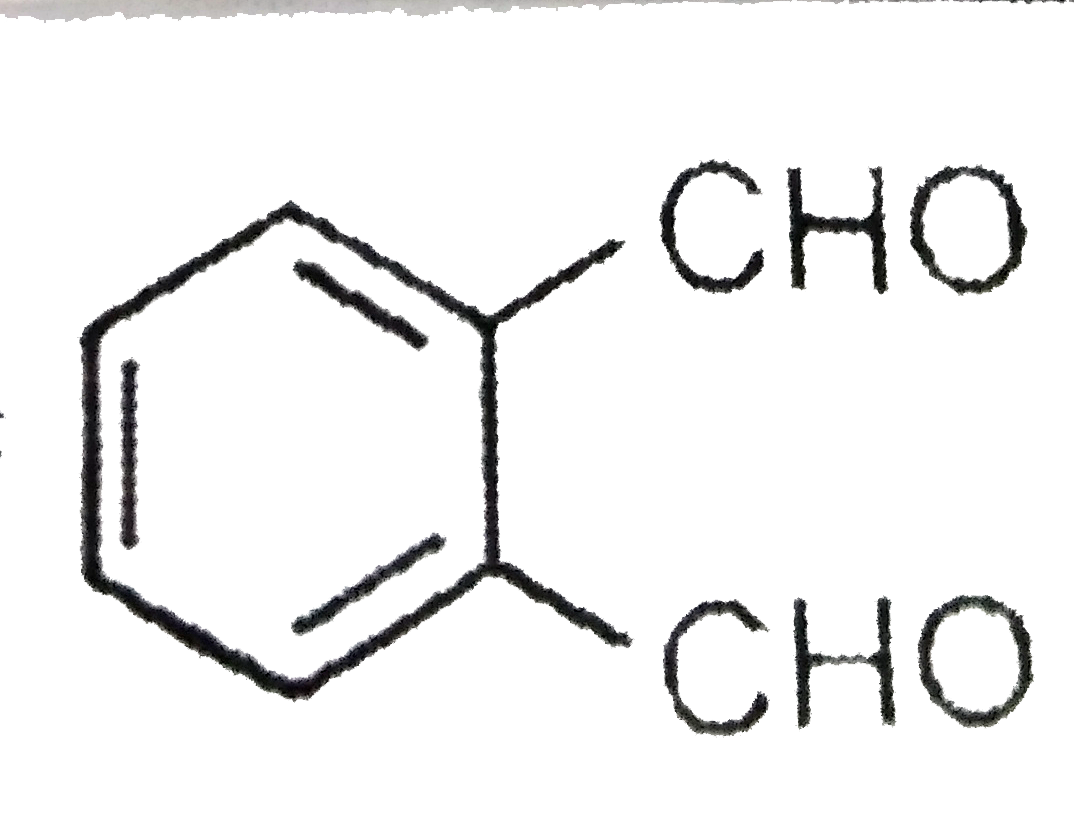Glyoxal (CHOCHO) on being heated with concentrated NaOH forms
The correct Answer is:
To determine the product formed when glyoxal (CHOCHO) is heated with concentrated NaOH, we can follow these steps:
Step 1: Identify the Structure of Glyoxal
Glyoxal has the structure HCHOCHO, which can be represented as:
O||H−C−C−H||O
This indicates that glyoxal contains two aldehyde groups.
Hint: Recognize the structure of glyoxal and its functional groups.
Step 2: Reaction with Concentrated NaOH
When glyoxal is heated with concentrated NaOH, it undergoes a reaction that involves the nucleophilic attack of hydroxide ions (OH⁻) on the carbonyl carbon of one of the aldehyde groups.
Hint: Understand that hydroxide ions can act as nucleophiles in reactions with carbonyl compounds.
Step 3: Formation of Alkoxide Intermediate
The hydroxide ion attacks one of the carbonyl carbons, leading to the formation of an alkoxide intermediate. The reaction can be illustrated as follows:
O∣∣∣∣H−C−C−H+OH⁻→H−C−C−O⁻∣∣∣∣∣OH
Hint: Remember that the nucleophilic attack results in the formation of an alkoxide ion.
Step 4: Intramolecular Cannizzaro Reaction
Glyoxal can undergo an intramolecular Cannizzaro reaction, where one aldehyde group is oxidized to a carboxylic acid while the other is reduced to an alcohol. In this case, one hydrogen atom from the hydroxymethyl group leaves, and the bond shifts, resulting in the formation of a carboxylate ion.
Hint: Recognize that the Cannizzaro reaction typically occurs with non-enolizable aldehydes, leading to disproportionation.
Step 5: Final Product Formation
The final product of the reaction can be represented as:
O∣∣∣H−C−C−O⁻∣∣OH
This can be written as CH₂(OH)COO⁻, which indicates the formation of sodium glycolate (the sodium salt of glycolic acid).
Hint: Identify the final product by recognizing the functional groups present after the reaction.
Conclusion
The product formed when glyoxal is heated with concentrated NaOH is sodium glycolate (CH₂(OH)COO⁻).
Glyoxal has the structure HCHOCHO, which can be represented as:
O||H−C−C−H||O
This indicates that glyoxal contains two aldehyde groups.
When glyoxal is heated with concentrated NaOH, it undergoes a reaction that involves the nucleophilic attack of hydroxide ions (OH⁻) on the carbonyl carbon of one of the aldehyde groups.
The hydroxide ion attacks one of the carbonyl carbons, leading to the formation of an alkoxide intermediate. The reaction can be illustrated as follows:
O∣∣∣∣H−C−C−H+OH⁻→H−C−C−O⁻∣∣∣∣∣OH
Glyoxal can undergo an intramolecular Cannizzaro reaction, where one aldehyde group is oxidized to a carboxylic acid while the other is reduced to an alcohol. In this case, one hydrogen atom from the hydroxymethyl group leaves, and the bond shifts, resulting in the formation of a carboxylate ion.
The final product of the reaction can be represented as:
O∣∣∣H−C−C−O⁻∣∣OH
This can be written as CH₂(OH)COO⁻, which indicates the formation of sodium glycolate (the sodium salt of glycolic acid).
The product formed when glyoxal is heated with concentrated NaOH is sodium glycolate (CH₂(OH)COO⁻).
Topper's Solved these Questions
- CARBONYL COMPOUNDS (ALDEHYDES & KETONES ) & CARBOXYLIC ACID BOOK - RESONANCE ENGLISHCHAPTER - CARBONYL COMPOUNDS (ALDEHYDES & KETONES ) & CARBOXYLIC ACID EXERCISE - Exercise-1 Part-II
1 Videos
- CARBONYL COMPOUNDS (ALDEHYDES & KETONES ) & CARBOXYLIC ACID BOOK - RESONANCE ENGLISHCHAPTER - CARBONYL COMPOUNDS (ALDEHYDES & KETONES ) & CARBOXYLIC ACID EXERCISE - Part-II
64 Videos
- CARBONYL COMPOUNDS (ALDEHYDES & KETONES ) & CARBOXYLIC ACID BOOK - RESONANCE ENGLISHCHAPTER - CARBONYL COMPOUNDS (ALDEHYDES & KETONES ) & CARBOXYLIC ACID EXERCISE - Part -IV
23 Videos
- BIOMOLECULES & POLYMERBOOK - RESONANCE ENGLISHCHAPTER - BIOMOLECULES & POLYMEREXERCISE - ORGANIC CHEMISTRY(Biomolecules & Polymer)
34 Videos
- CHEMICAL KINETICSBOOK - RESONANCE ENGLISHCHAPTER - CHEMICAL KINETICSEXERCISE - PHYSICAL CHEMITRY (CHEMICAL KNIETICS & RADIOACTIVITY)
49 Videos
Similar Questions
Knowledge Check
Phenylglyoxal, (C6H5COCHO), on heating with concentrated NaOH gives:
AC6H5COONa and CH3OHBC6H5CH2OH and HCOONaCC6H5CHOHCOONaDC6H5COONa and HCOONaAn organic compound having the molecular formula C8H10O on being heated with I2 and dilute NaOH gives a yellow precipitate. The expected compound is :
AC6H5CH2CH2OHB C
C D
D
An organic compound A–– react with sodium to form another compound B–– . The compound A–– when heated with concentrated H2SO4 forms diethyl ether . The compound A–– and B–– are respectively
View SolutionA white solid imparts a violet colour to a Bunsen flame. On being heated with concentrated H2SO4, the solid gives violet vapours that turn starch paper blue. The salt may be :
View SolutionKMnO4 in excess on treatment with concentrated H2SO4 forms a compound (X) which decomposes explosively on heating forming (Y). The (X) and (Y) are respectively.
View SolutionCyclohexanone on being heated with NaOH solution forms.
View Solution(a)What happens when white phosphorus is heated with concentrated NaOH solution in an inert atmosphere of CO2?
(b)Draw the structure of white phosphorus and red phosphorus. Which one of these two types of phosphorus, is more reactive and why ?
View SolutionGlycerol on being heated with an excess of HI produces
View Solution

 with concentrated NaOH gives
with concentrated NaOH gives